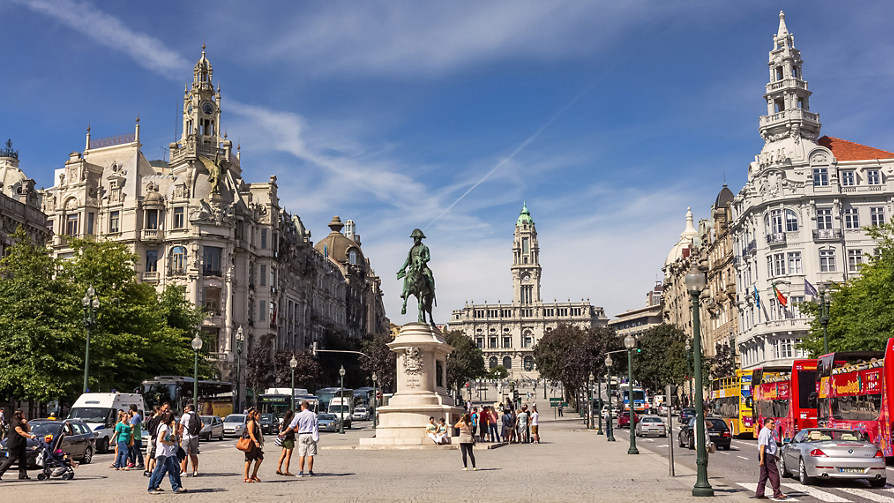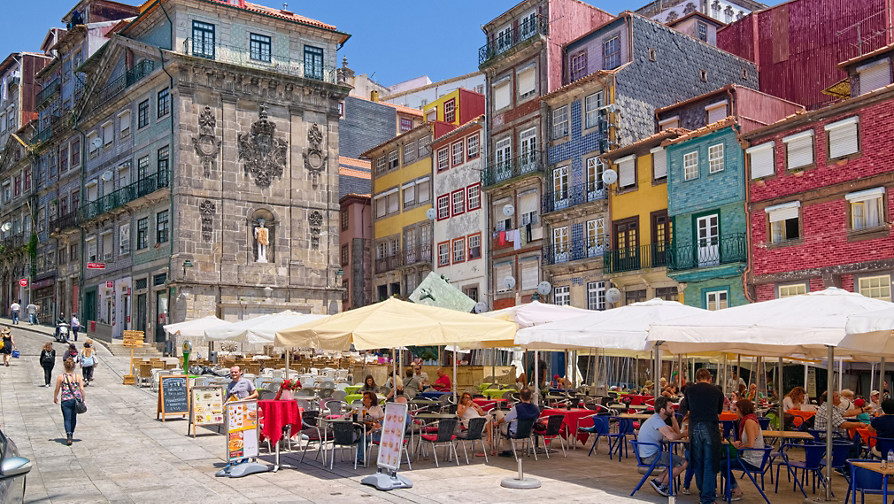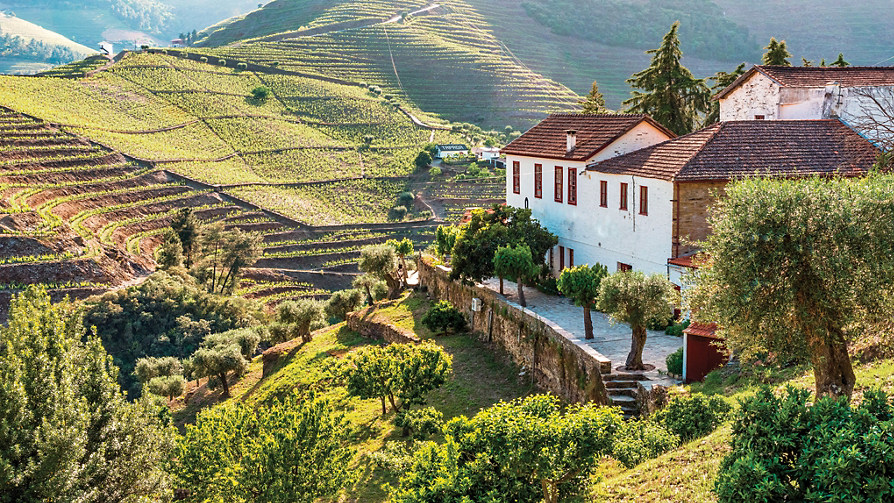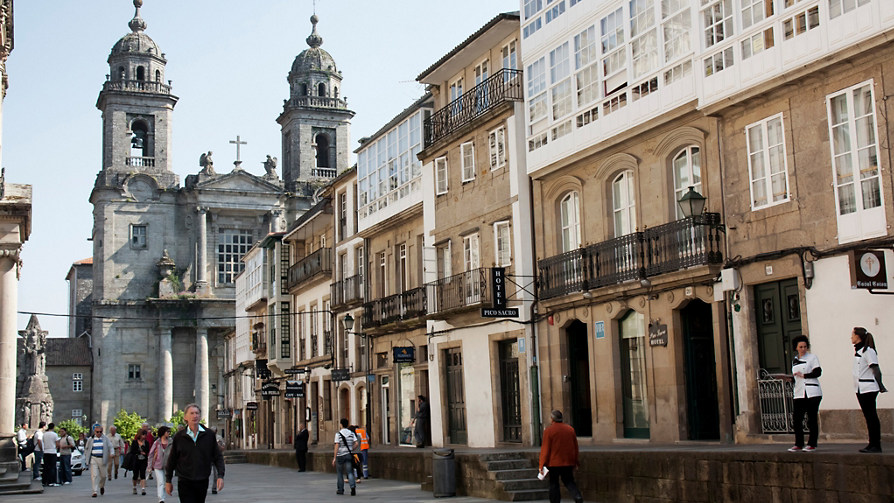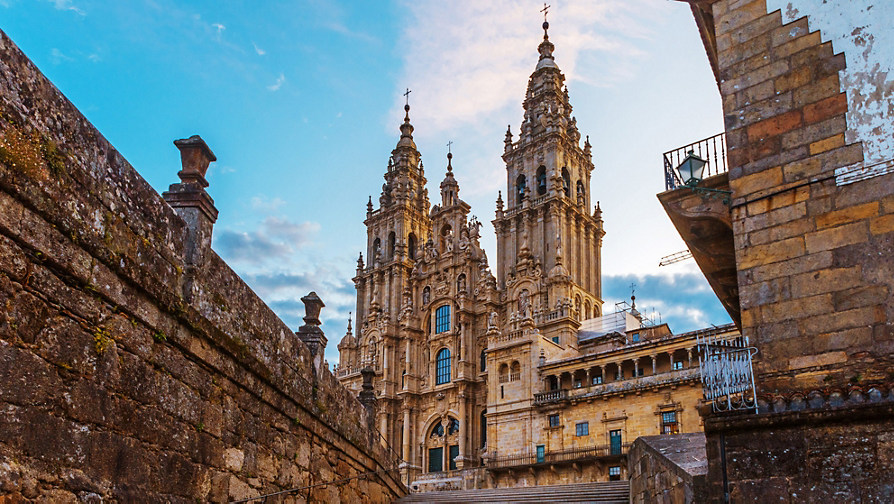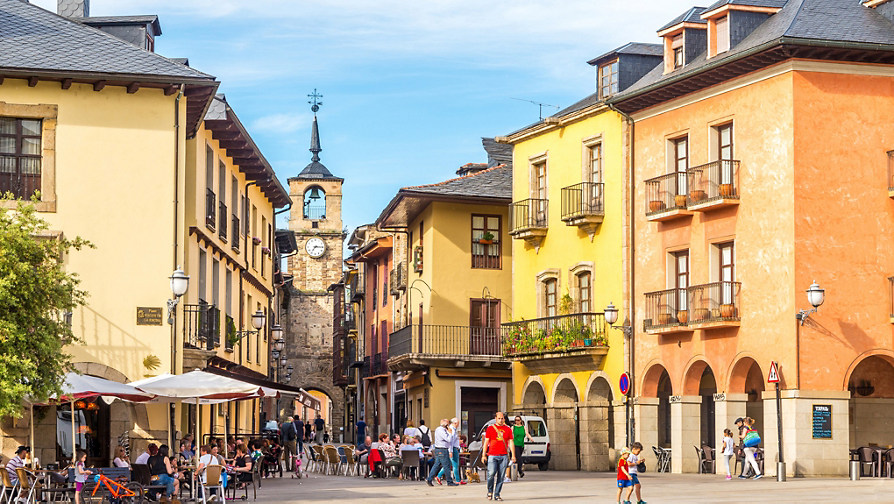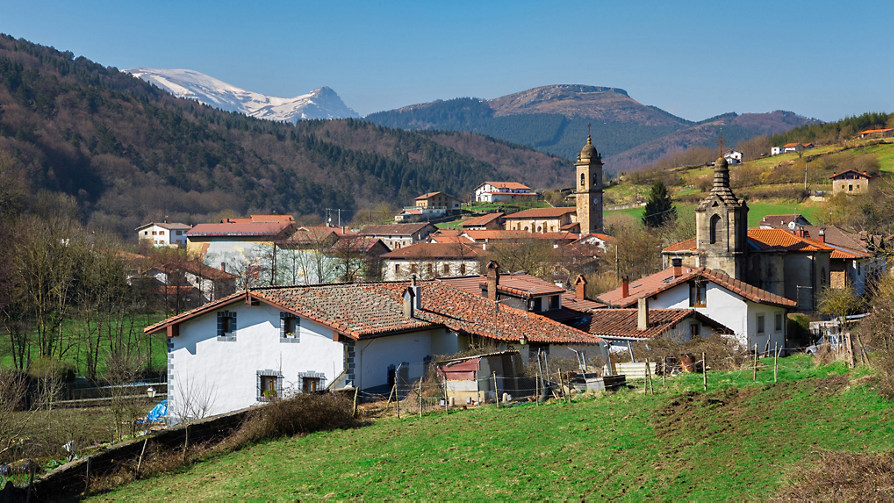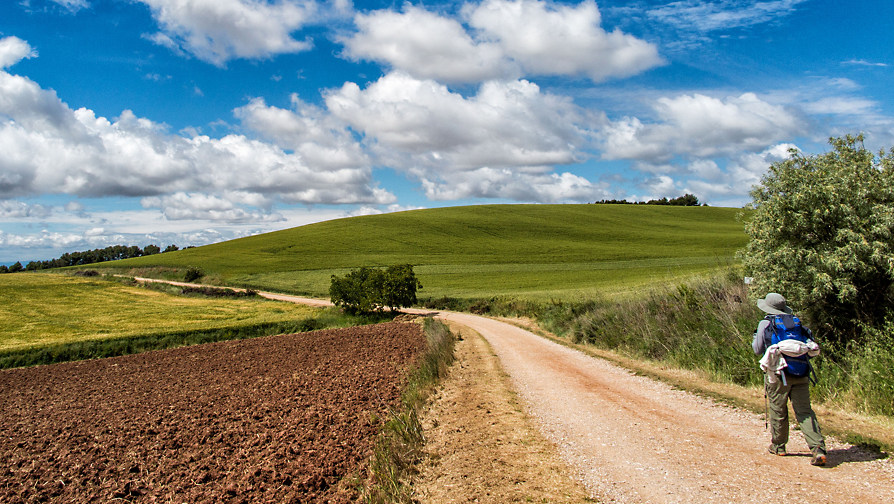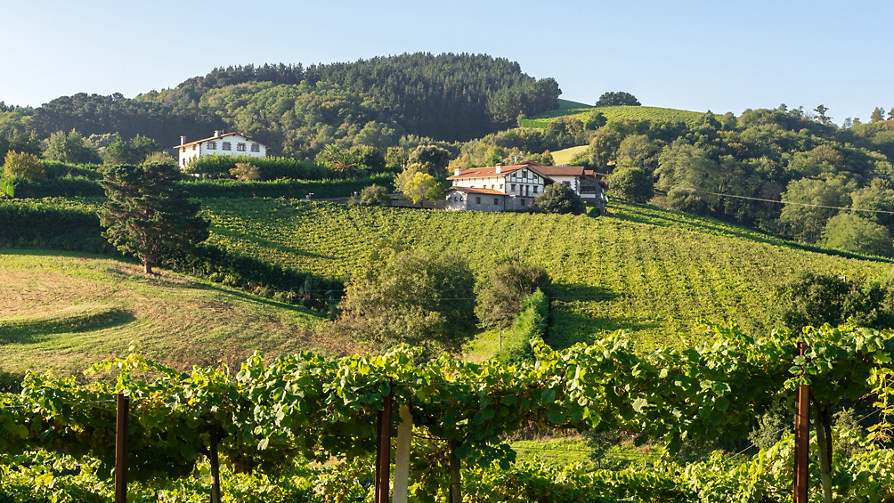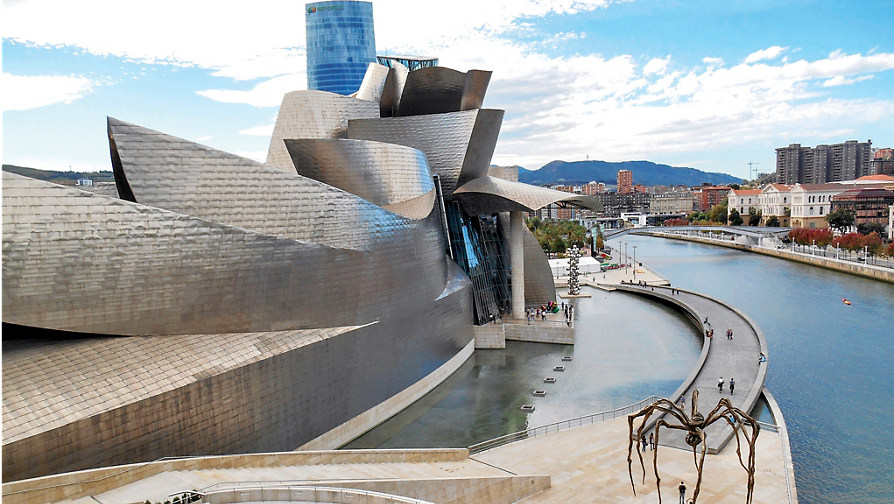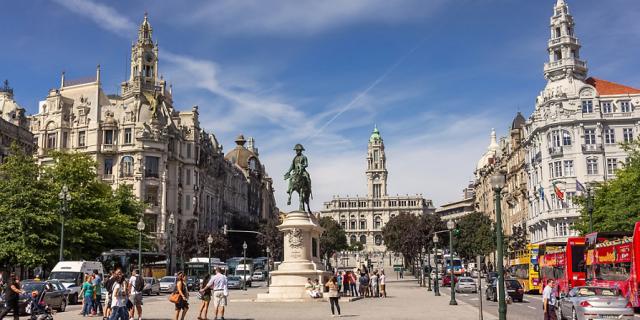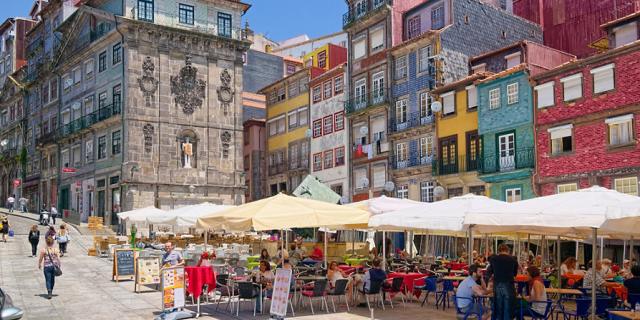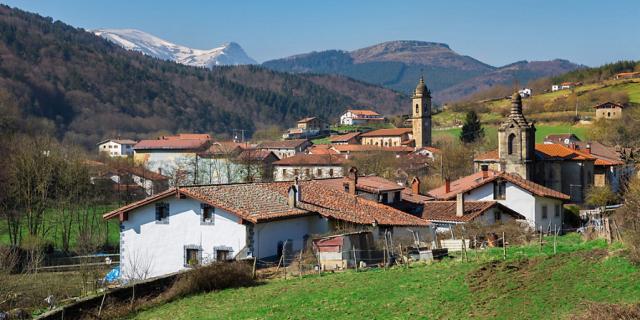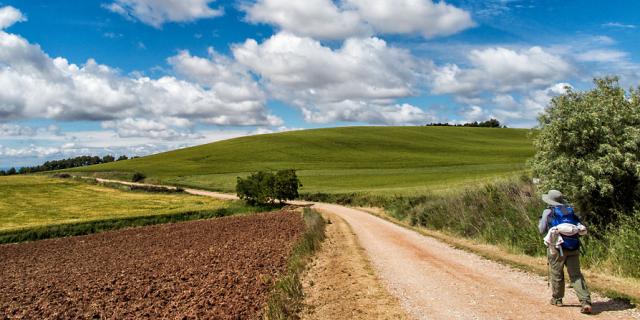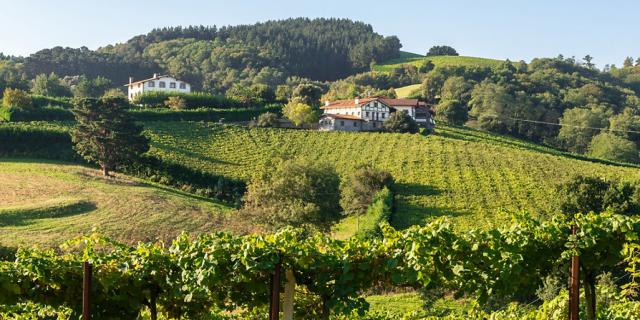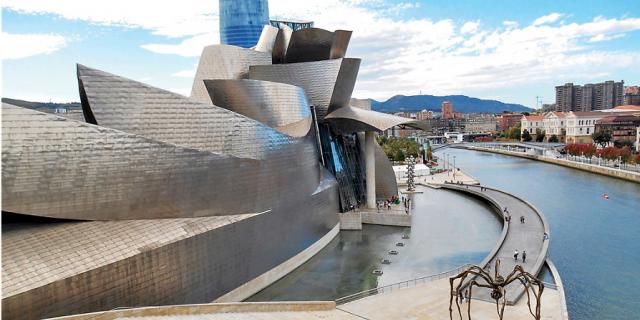- Explore in a small group of 8-16 travelers (average group size of 13)
- All land transportation
- Accommodations for 15 nights
- 33 meals—16 breakfasts, 9 lunches, and 8 dinners (including 1 Home-Hosted Lunch)
- 15 small group activities
- Services of a local O.A.T. Trip Experience Leader
- Gratuities for local guides, drivers, and luggage porters
- 5% Frequent Traveler Credit toward your next adventure
Please note:
Deposit requirement on land trips is $350
Past traveler savings of 5% if you traveled from 2018 onward
New travelers get $100 savings
Follow the path of ancient pilgrimage routes on a journey from the Basque capital of Bilbao and Hemingway’s beloved Pamplona to legendary Santiago de Compostela and find out why 88% of travelers rated this trip excellent. Throughout this Portugal and Spain travel experience, you’ll witness the full breadth of the region’s delights—including the azure waters of Concha Bay in San Sebastian and the maze-like streets of León—as well as savor local tastes when you sample wine and enjoy a Home-Hosted meal. The discoveries continue as you explore the rich traditions of Galicia, Spain’s northernmost region, and the lush riverside Douro Valley of Portugal. Crown your journey in history-soaked Porto, the coastal city that launched so many explorers.
And in the intimate setting afforded to us by our small group size, we'll be able to interact with vineyard owners, local families, and perhaps even modern-day pilgrims as we traverse a portion of the historic Camino de Santiago. We'll meet with locals to delve into Controversial Topics like the violent struggle for Basque independence and running of the bulls in Pamplona. As you explore villages up to 3,000 years old, you’ll visit five UNESCO World Heritage Sites, and with strolls through historic markets, you’ll see what makes the enduring cultures of these two countries so unforgettable. To get a sense of what everyday life is like in these small towns, you'll spend A Day in the Life of Santa Colomba de Somoza, where you'll visit a traditional craft center supported by Grand Circle Foundation. To discover one of the oldest wine producing areas in the world, be sure to join O.A.T.—because you won't find a Northern Portugal itinerary with an overnight stay in the Duoro Valley at any other travel company. And whenever you’d like, you have the freedom to explore more of the Iberian peninsula on your own: Break off from the group for independent discoveries—Santiago’s Alameda Park, Porto’s Serralves complex, and more—during free time.
DAY 1
Depart U.S.
Destination: Bilbao
You depart today on your overnight flight from the U.S. to Bilbao, Spain.
DAY 2
Arrive in Bilbao, Spain
Destination: Bilbao
Accommodations: Hotel Abando or similar
Morning: You’ll arrive in Bilbao, the capital of Spain’s Biscay province, in the mid- to late-morning, depending on your specific flight arrangements. An O.A.T. representative will meet you at the airport and escort you to your hotel via bus—a transfer of about 25 minutes, depending on traffic. Here we’ll be joined by travelers who took our optional Carcassonne, Bayonne & French Basque Country and New! Valencia, Zaragoza & the Rioja Wine Region extensions. For those who arrive before check in time, your Trip Experience Leader will organize an optional orientation walk to help travelers get familiarized with the area.
Lunch: On your own. You are free to settle in at the hotel restaurant, or venture out to start your explorations of Bilbao independently. Perhaps you'll seek out "bonito de norte," a traditional tuna dish, or "jamon de bellota," an Iberian ham dish.
Afternoon: After 2pm, you will check in and receive your room assignment. We stay for three nights in our hotel—depending on which hotel we stay at, we’re likely to be in walking distance of two renowned Basque Country museums, the Bilbao Guggenheim and the Bilbao Fine Arts Museum. Entrance fees to the museums will be provided to you. On-site amenities may include a restaurant and bar; and your room is likely to feature air-conditioning, a minibar, TV, safe, and private bath with hair dryer.
The rest of the afternoon is yours, with the freedom to rest in your room, explore the hotel grounds, or stroll to the nearby Gardens of Albia. Around 6pm, we’ll then embark on a 30-minute walk around the hotel and surrounding area. This gives us a chance to get acclimated, find an ATM, or seek out a local market.
Dinner: On your own this evening. Bilbao is world-renowned for its dining scene, with culinary traditions and flavors distinct from the rest of Spain. Your Trip Experience Leader is sure to have suggestions for a fitting introduction to the acclaimed local cuisine. You may want to venture to Zaharra, a nearby restaurant offering fantastic tortilla de txipis, large tortillas with candied onions. Or, give Basque Vintage Restaurant a try, where chuleton con piquillo—or beef with pepper—attracts repeat customers.
Evening: You are free to rest in your room after your flight, or reach out to your Trip Experience Leader for recommendations on how to discover this cultural hub.
DAY 3
Explore Bilbao
Destination: Bilbao
Meals included: B D
Accommodations: Hotel Abando or similar
Breakfast: Served buffet-style at the hotel beginning at 7:30am, with Spanish and international options available.
Morning: Around 9am, we’ll gather in the hotel and meet with our Trip Experience Leader for a Welcome Briefing. During this briefing, we will introduce ourselves and review our itinerary in more detail (including any changes that may need to occur). Our Trip Experience Leader will also discuss logistics, safety and emergency procedures, and answer any questions we may have. Then around 10am, we'll board our bus to set off for a panoramic tour of Bilbao. Since at least the 14th century, Bilbao has been a scene of industry and culture, known especially for its ironworks—Shakespeare even refers to swords as “bilboes” in Merry Wives of Windsor. As the centuries passed, the city developed into a shipbuilding center; by 1900, it was the wealthiest city in all of Spain. But the middle of the 20th century saw natural disasters and civil war cripple the city, to the point that some believed Bilbao’s glory days were past. Happily, in the late 1990s the city came roaring back to life.
We'll get off our bus and begin our walking tour around 11:45am beginning with a stroll through the medieval Old Town. This area is also known as the “Seven Streets” neighborhood because in the heart of the Old Town are Bilbao's original seven streets, which date to the 14th century and are the origin of the city. Around 1:15pm, we'll conclude our discoveries and take the local tram back to our hotel where you'll have the afternoon free to explore the city on your own.
Lunch: On your own. Perhaps you'll cross the Nervión River from our hotel—about 10 minutes away by bus—to dine at one of the many restaurants in the area. Some favorite local dishes include huevos rellenos—stuffed boiled eggs and tortillas—and pintxos, small finger foods served throughout Basque country.
Afternoon: You have the freedom to enjoy this fascinating city independently. You might choose to pay a visit to Indautxu Square: In this urban redesign project, a pedestrian-only plaza has been studded with maple, birch, and yew trees, as well as leaf-shaped lighting fixtures, all encircling a ring of benches beneath glass canopies. Perhaps you'll discover modern art at the Guggenheim Museum and explore the grounds of this innovative architectural landmark. (Your Trip Experience Leader will provide entry tickets.) Or you may prefer to find a local café at which you can savor a glass of zurito, beer served in a small glass—the popular way to order and enjoy the beverage here. We will reconvene at the hotel around 6:15pm to walk about 10 minutes to dinner.
Dinner: At about 6:30pm, we'll enjoy a Welcome Dinner at a local restaurant.
Evening: We'll walk back to the hotel around 8pm and the remainder of the evening will be on your own. Your Trip Experience Leader will be happy to provide recommendations on how you can spend this free time—perhaps you’ll seek out the Teatro Arriaga. Inspired by the Palais Garnier in Paris, this riverside Neo-baroque opera house is particularly special when the exterior is illuminated at night.
DAY 4
Bilbao • Controversial Topic: The violent struggle for Basque independence from 1959 to today with nationalist Ene or Fran • Discover Guernica • Txakoli wine tasting
Destination: Bilbao
Meals included: B L
Accommodations: Hotel Abando or similar
Exclusive O.A.T. Activity: Today will discuss the Controversial Topic of the Basque independence movement, and the radical political organization known as ETA that used violence to promote revolution. We'll be joined by Fran or Ene, a speaker with pro-independence views and first-hand insight into the ETA's methods and beliefs. Read more about this challenging conversation below.
Breakfast: Served buffet-style at the hotel beginning at 7am, with Spanish and international options available.
Morning: Around 8:45am, we’ll set off to explore the Basque Coast, beginning with a bus journey to Guernica. In 1937, the German Luftwaffe bombed Guernica nonstop for more than three hours, laying waste to almost all of it—a nightmare immortalized by Picasso in the famous painting that bears the town’s name. Upon arrival around 9:30am, we'll discover Picasso's famous "Guernica" mural. Our Trip Experience Leader will share some of the history behind the mural before we continue on to Casa de Jubilados, a former World War II bomb shelter that now serves as a community center for senior citizens.
Then, we’ll head to a private, back room inside the center's café to learn about the Controversial Topic of the Basque independence movement, and in particular, a radical (and often violent) wing of the Basque Independence Party called Euskadi Ta Askatasuna (meaning “Basque Motherland and Freedom” in the native Basque language). The goal of ETA, as the organization is known, is simple: for the Basque state to become its own self-governing country, independent from Spain. But as we will find out, the group’s means of achieving that goal are hotly contested by most Spaniards.
To teach us more about this topic, we’ll hear from one of two locals with strong pro-independence views: Ene and Fran, who have both witnessed the ETA's methods first-hand. Membership in ETA is illegal, and so these locals—while not members themselves—are taking a considerable risk to speak to us, which is why the location of our hour-long meeting is so secluded. Ene or Fran will share their own experiences with ETA for approximately 20 minutes, then invite you to ask any questions you may have.
After the Spanish Civil War of the 1930s, General Franco rose to power on a right-wing, Catholic, nationalist platform that sought to impose conformity across the country. The Basque Country, however, had long seen itself as distinct from that of the rest of the country. The region has its own language, a proud history, and unique cultural traditions. But under Franco, speaking Basque was banned, Basque traditions and celebrations were forbidden, and members of Basque political organizations were tortured and imprisoned.
The seeds of Basque independence had actually been planted in 1894, when the Basque Nationalist Party (Partido Nacionalista Vasco or PNV) was formed with the goal of protecting Basque culture. However, the mistreatment of the Basque people under Franco’s regime galvanized the movement; in 1959, youthful idealists who had grown frustrated with PNV's non-violent responses to Franco's oppression split from PNV to form the revolutionary ETA. Throughout the 1960s, ETA evolved into a paramilitary organization engaged in violent campaigns, including assassinations of high-ranking government officials and bombings of civilian and military targets throughout Spain. Franco's attempts to quell the group's attacks were severe: Members were routinely arrested, beaten, and tortured for their participation. By 1970, the key leaders had all be rounded up and put on trial—but their arrests were not enough to stop the violence.
Following Franco's death in 1975, Spain's newly-elected democratic leaders attempted to make peace with ETA, promising regional autonomy for Basque provinces and even offering to pardon some ETA prisoners. The approach, however, proved to be spectacularly ineffective: In the decades that followed, ETA violence increased ten-fold. All told, there have been 864 deaths, of which more than 350 were civilian casualties, as a result of ETA’s activities.
This decades-long violence sparked outrage and fear among Spaniards, leading them to view ETA not as a political organization with a worthy cause but as terrorists. To members of ETA, however, their violence was justified as a necessary means to achieve equality and independence for the Basque people. Because our guest speaker grew up in Basque Country and speaks the Basque language, he or she will be able to offer a deeply personal perspective on why independence continues to be so important to the Basque community, and how the fight for independence has affected his or her families and communities.
In 2011, a cease-fire was declared between ETA and the Spanish government, and the organization technically disbanded. However, in the years that followed, evidence of ongoing ETA activities was uncovered—including hidden caches of guns and ammunition. In 2018, the international community formally recognized the end of the ETA, although many believe it still exists and has merely gone underground. Independence has still not been achieved, though many Basque people still actively support the independence movement. Whatever your feelings on ETA’s methods, our conversation today will likely bring up age-old (and still relevant) questions about forms of protest, revolution, and the role of democracy in a healthy society. As we continue our journey throughout Spain, be on the lookout for portrayals of the Basque people and the Basque independence movement in mainstream Spanish news and media. It will be interesting to compare these portrayals with your own experience of the movement from our conversation in Guernica.
Around 11:45am, we board our bus to continue on to a family-run winery, arriving about one hour later. At the wine cellar, we’ll learn about txakoli wine. This sparkling dry white was once just a homemade favorite. Because its shelf life is short—it has to be poured and enjoyed within a year of its bottling—it was treated more like canning or preserves, an annual ritual as part of the harvest season. It wasn’t until the end of the 20th century that several vineyards sought and won Designation of Origin certification, which boosted txakoli’s name recognition and introduced it to an enthusiastically receptive wider audience. During our visit, we’ll meet the people who make this Basque favorite—and, thanks to our small group size, we'll have the opportunity to connect with them one-on-one. As we stroll through the vineyards, we'll learn about the history of the wine and its unique flavor profile. We'll put that knowledge to the test when we a chance to sample txakoli for ourselves.
Lunch: Around 1pm at the winery. We'll enjoy a meal with the winery owner who will share insight into their daily lives and the local culture.
Afternoon: After lunch around 2pm, we’ll spend about 30 minutes touring the production area of the winery to enrich our understanding of the full life cycle of txakoli. Then, we'll begin the 1-hour return trip to Bilbao by bus, arriving at our hotel around 3:15pm. The rest of the afternoon is free to explore at your leisure.
Dinner: On your own. You’re free to seek out your own Basque culinary experience, and your Trip Experience Leader is happy to provide you recommendations. Perhaps you’ll want to sample txangurros (spider crabs), which are typically stuffed with crab meat, onion, tomato, herbs, and bread crumbs before they’re baked in the oven. Or, you’ll delve into the world of pinxtos, the Basque answer to tapas.
Evening: If you’d like, you have the freedom to rest up before tomorrow’s transfer to Pamplona. Or, you can ask your Trip Experience Leader for tips on how to spend your final evening in Bilbao.
DAY 5
Bilbao • San Sebastian excursion with Basque lunch • Overland to Pamplona
Destination: Pamplona
Meals included: B L
Accommodations: Tres Reyes Hotel or similar
Activity Note: Today's transfer from Bilbao to Pamplona will involve a 3-hour bus ride with stops along the way, including a 2-hour walking tour.
Breakfast: Served buffet-style at the hotel beginning at 7am, with Spanish and international options available.
Morning: We bid farewell to Bilbao around 9:30am this morning, when we board our bus for our full-day journey (with stops along the way) to Pamplona, in the heart of Basque country. While experts have traced references to “Basque” all the way back to the mid-16th century, the original etymology of the word remains up for debate. The rolling landscapes we’ll witness during this morning’s journey make a convincing case for one of the theories: “the mountain people.” Today, however, the word is commonly used to describe regions in Spain and France in which the indigenous Basque ethnic group dwells.
While Pamplona is nestled inland, within a rounded valley, we’ll take the coastal route to get there—which gives us the opportunity to visit seaside San Sebastian, Spain's gourmet capital, along the way. We’ll arrive in San Sebastian proper around 11am, and get to know the city by foot during a walking tour of just over an hour. The city’s longtime commercial success will be on display as we pass grand 19th-century buildings and lovely gardens. Around 11:45am, we'll continue from Miramar Gardens along the Concha Bay to the labyrinthine streets of the old quarter, finishing up near the local market.
Around 1:15pm, we will walk 15 minutes to lunch.
Lunch: At a local restaurant in San Sebastian around 1:30pm, featuring Basque options.
Afternoon: At about 3:15pm, we’ll make the 15-minute walk back to our bus and continue our travels inland to Pamplona, located a little more than an hour to the south. After arriving at our hotel around 5pm, we’ll check in, get our room assignments, and enjoy some free time to settle in. Depending on which hotel we stay at, we’re likely to be within walking distance of some of the city’s most well-known features—Pamplona Cathedral, the Museo de Navarre, and Plaza del Castillo. On-site amenities may include a bar/lounge, while your room is likely to feature a TV, minibar, safe, wireless Internet, and a private bath with hair dryer. After enjoying some time to get settled in, you may choose to join an optional orientation walk with our Trip Experience Leader around the vicinity of our hotel.
Dinner: On your own. Your Trip Experience Leader is always happy to provide suggestions. Some notable restaurants in the area that you may want to try include El Gaucho and La Cocina de Alex Múgica.
Evening: On your own, with freedom to relax in your room, linger over a drink at the bar, or venture out into Pamplona to begin your discoveries independently. Your Trip Experience Leader can provide recommendations for where to go and what to try.
DAY 6
Controversial Topic: The morality of Spain's running of the bulls tradition through the eyes of Gorka Cia, a long-time participant • Walk the Camino de Santiago • Pamplona
Destination: Pamplona
Meals included: B L
Accommodations: Tres Reyes Hotel or similar
Exclusive O.A.T. Activity: Today we'll discuss the Controversial Topic of Pamplona's 200-year-old running of the bulls tradition with local resident and long-time participant, Gorka Cia. In recent years, this cultural event has drawn the ire of animal rights activists, who see it not as a beloved tradition, but as an act of cruelty. This conversation will encourage us to consider this iconic event from multiple perspectives. Read more about the conversation below.
Activity Note: Today is a very rigorous day, as we embark on a mile-long hike on a steep, unpaved road, and then a 2.5-mile hike along forest trails. If you’ve brought a hiking stick with you on this adventure, today is a day you will want to have it on hand—to best allow you to experience these historic and popular treks.
Breakfast: Served buffet-style at the hotel beginning at 7am, with Spanish and international options available.
Morning: This morning, we’ll board the bus around 9:30am for a 45-minute ride to Roncesvalles, a village known as the setting of the defeat of Charlemagne. Here, we’ll begin to discover the Camino de Santiago, one of Europe’s most important pilgrimage routes. During the Middle Ages, the three great Christian pilgrimage destinations were Rome, Jerusalem, and Spain’s Santiago de Compostela, where it was believed a cathedral housed the bones of St. James. “The Way of St. James” is a series of walking routes that led from various locations in Spain, Portugal, and France to the Cathedral of Santiago de Compostela (the most popular trek is known as the French Way, which crossed the Pyrenees). Today, the route remains a popular journey for the devout—as well as a beloved itinerary for hikers and cyclists. Foreigners and people from Spain alike travel here to witness the historic, scenic locale, and we’re starting here in Roncesvalles because that’s the way many pilgrims have begun the trek over the centuries. The meaning of the route will come to life along the way, as we walk the first mile of our journey. Our small group size gives us the chance to talk to pilgrims who are making the hike for spiritual reasons, and to hear their candid perspective on what the journey means to them.
Then, we'll take a second walk, approximately two miles in length through the northern Spanish forests before boarding the bus around 12:30pm for a 5-minute drive to a local restaurant for lunch.
Lunch: We’ll pause around 12:30pm for lunch at a local restaurant, which gives us the opportunity to rest our legs and fuel up for the afternoon.
Afternoon: Around 1:45pm, we'll depart for the drive back to our hotel in Pamplona, arriving around 3:15pm.
Then, around 4pm we’ll meet Gorka Cia, a local resident who will lead us on a 1.5-hour walking tour of his home city, Pamplona, made famous by the San Fermin festival—and specifically, its raucous (and sometimes deadly) running of the bulls. This breakneck event, during which bulls tear through the crowded streets of Pamplona before ultimately meeting their demise in the city's bullring, has been a tradition since the 13th century. However, over the last 15 years, many Spaniards have grown concerned about the bulls' welfare and have begun calling for an end to the race, which they see as outdated and cruel. As a long-time resident of Pamplona, Gorka has had a front-row seat to the mounting controversy. But as lover of Spanish tradition and culture, he has also participated in the encierro (bull run) several times—and as he leads us along the path of the bulls, he'll also lead a conversation about this Controversial Topic.
While the running of the bulls may seem to be pure spectacle today, its origins were actually quite practical: To transport their bulls to markets for sale, cattle herders and butchers would simply run their herds through the open countryside and into the city center. Over the years, locals began clearing paths through the city for the charging bulls, and goading them on by shouting and banging sticks. It's not known when, exactly, the modern bull-running tradition was born, but researchers believe it began sometime in the 1800s, with young daredevils jumping in front of the stampede to prove their bravery. The encierro's notoriety got a major boost in 1926, when Ernest Hemingway waxed poetic about Pamplona's "fiesta" in The Sun Also Rises.
Today, the bull run is not only Pamplona's signature attraction, but it's also a cornerstone of the city's economy. Every July, visitors from around the world flock to the San Fermin festival, and Pamplona's population balloons from 200,000 to over one million. These hundreds of thousands of party-goers add roughly $150 million to the city's coffers over the course of just nine days.
The festival may last more than a week, but the actual bull runs are comparatively very short: Every morning at 8am, six bulls are released from their pens and hurtle half a mile through narrow, crowd-choked streets to the city's bullring. The race takes about five minutes to complete; afterward, the mob piles into the bullring to watch the animals and matadors do battle.
Anyone over the age of 18 can join the bulls in their furious dash, though they do so at considerable risk. Every year, dozens of people are gored, trampled, and tossed by the raging herds; at least 15 people have died from their injuries since officials began keeping records in 1924. The bulls do not escape unscathed, either: Animal rights activists contend that the bulls are agitated with electric prods and sharp sticks prior to the race, and weakened with laxatives. As the animals tear through the streets, drunken revelers shout and slap at them. And while they ultimately find some peace inside the bullring, it's short-lived: Almost none of the bulls make it out alive. In the days leading up to San Fermin, hundreds of protesters covered in fake blood take to the streets of Pamplona to call for an end to the bull runs.
As we follow the route of the encierro, Gorka will share personal stories from past festivals and explain why the bull run has such a romantic appeal for him and his countrymen. He'll also delve into the controversy surrounding the event—and bullfighting as a whole. The sport is protected by the constitution as part of Spain's cultural heritage, but a recent poll revealed that it's falling out of favor: 60% of Spaniards are opposed to bullfighting. During this informal dialogue, you're free to ask any questions you have about San Fermin, the bull runs, or bullfighting—from how the bulls are chosen, to the impact tourism has had on the festival.
Our walk concludes at Café Iruna, Ernest Hemingway’s beloved haunt on the Plaza del Castillo, around 6pm. Then, the rest of the day is free for you to explore at your own pace.
Dinner: On your own. Your Trip Experience Leader can provide recommendations on where to dine tonight—and you may decide to seek out estofado de toro. This traditional stew not only features vegetables like potato, carrot and onion, it also includes bull’s tail for a fitting nod to Pamplona’s fame.
Evening: You’re free to explore on your own tonight. Perhaps you'll opt for a leisurely stroll through Pamplona's Riverside Park, where you'll witness Roman ruins tucked into tranquil natural scenery.
DAY 7
Explore Ubidea & Otxandio • Overland to León
Destination: León
Meals included: B L
Accommodations: Sercotel Alfonso V or similar
Breakfast: Served buffet-style at the hotel beginning at 7am, with Spanish and international options available.
Morning: Around 8:30am, we’ll board our bus to set off for the Basque countryside to discover two authentic, off-the-beaten-path destinations: Ubidea and Otxandio. Matriarchal societies are the norm in this remote region of Spain; during our explorations today, we'll learn more about the impact of female leadership on everyday life. At approximately 10:15am, we'll arrive in Oxtandio, first town to be bombed during the Spanish Civil War. After stopping for coffee in the main square, we'll visit a local cosmetics laboratory and meet its two female founders. All of the products produced here are made from natural, plant-based ingredients. We'll learn about the products—and about the inspiration behind this women-owned business—during our 20-minute visit.
Our next stop, Ubidea, is approximately 45 minutes away. With just 175 inhabitants, Ubidea is one of the smallest towns in Basque Country. As you stroll along its ancient streets, you may feel as though you've stepped back into the Middle Ages. Around 12:30pm we'll set out to explore Ubidea's archaeological center. During our 1-hour visit, we'll meet with an archaeologist and visit the laboratory to learn what the skeletal remains from this region can tell us about the past and the present.
Lunch: At approximately 1:30pm, we'll head to a local tavern to enjoy a light lunch. The highlight of our meal will be pagobieta, a hard sheep's milk cheese typical of the Basque countryside.
Afternoon: We’ll begin our journey to León around 3:30pm, arriving approximately three hours later. We'll check in to our hotel and get our room assignments. Depending on which hotel we stay at, we’re likely to be right in the city’s main square, near iconic sites and a variety of bustling restaurants and tapas bars. Your air-conditioned room may include a minibar, TV, wireless Internet, coffee- and tea-making facilities, and a private bath with hair dryer.
After settling in, you may want to join our Trip Experience Leader for a discovery walk around the neighborhood surrounding the hotel.
Dinner: On your own. During our discovery walk, our Trip Experience Leader will be happy to point out delicious options serving local fare.
Evening: Free for you to rest after the highly active past two days, or venture out into the city. Our Trip Experience Leader is ready to offer recommendations, if you wish.
DAY 8
A Day in the Life of Santa Colomba de Somoza • Grand Circle Foundation visit: Maragato Crafts Center
Destination: León
Meals included: B L
Accommodations: Sercotel Alfonso V or similar
Exclusive O.A.T. Activities: We'll visit Santa Colomba de Somoza today to experience A Day in the Life of a traditional Maragato community. After learning about the town from a local leader, we'll visit the Maragato Craft Center, supported by Grand Circle Foundation since 2020. During our visit, we'll learn more about the steps the center is taking to preserve Maragato culture and attract young talent to Santa Colomba. Our experience concludes with lunch in a traditional Maragato home. Read more about these activities below.
Breakfast: Served buffet-style at the hotel beginning at 7am, with Spanish and international options available.
Morning: Around 8:30am, we'll depart by bus for the 1.5-hour drive to spend A Day in the Life in Santa Colomba de Somoza, a small village nestled in the historical region of la Maragatería. Residents of this remote region of Spain are known as Maragatos, and they are believed to be the last living decedents of the North African Berbers who arrived in Iberia in the eighth century. Unlike other Moorish groups who assimilated to Spanish culture after the Christian Reconquista in the 15th century, the agrarian Maragatos isolated themselves in the hills outside of León, and thus retained their own distinct identity. Women were known for their colorful head coverings and oversized jewelry, and houses were made of stone and featured doors large enough for wagons to pass through. The Maragatos were extremely successful traders for hundreds of years, but as Spain began to modernize in the 19th century, the Maragatos' rural way of life fell out of favor and the younger generations began emigrating to larger towns where work was more readily available. Today, the population of the Maragatería region has dwindled to just 4,000 people—and around 200 of those remaining Maragatos can be found in Santa Colomba de Somoza.
Upon arrival in this tiny hamlet around 10:15am, we'll meet with Oscar, a local resident, and spend about 30 minutes speaking with him at the town hall, which serves as the heart of the community. During our conversation, we’ll hear about the toll emigration has taken on Santa Colomba de Somoza and the surrounding villages, and about the efforts local leaders are taking to save their community and the Maragatería way of life. This initiative, known as "filling the empty Spain," includes offering free land to entrepreneurs who want to live and start businesses in Santa Colomba, and attempting to re-open schools to entice young families to settle in the village.
We'll see another one of these initiatives in action when we visit Maragato Crafts Center—a NEW Grand Circle Foundation site. We'll be greeted by Antonio, or another leader of the facility. Antonio is the director of the facility and a master craftsman, who will tell us about the center's mission.
Founded in 2019, the center strives to keep traditional Maragato and Spanish handicrafts alive by offering training programs to young people from Spain and beyond. From woodcarving, to leather work, and pottery, young craftspeople become masters of their trade, developing income-generating skills and keeping local culture alive. By attracting ambitious students to Santa Colomba, the center hopes to breathe life into a dying city. Since 2020, Grand Circle Foundation has donated more than $2,000 to the center with our travelers' help, which has been used to purchase tools and fund scholarships for lower income students.
After spending 10 to 15 minutes with Antonio, we'll venture inside one of the classrooms to meet the young artisans, view their work, and witness a few of their techniques. Then we'll put what we've learned to the test when we try our hand at making a Maragato craft of our own.
Around 11:30am, we'll delve into the village's agrarian roots when we visit a local beekeeper, also named Oscar. Honey production has long been an important trade in this region, and in the León province as whole. Around 1,000 beekeepers can be found in León, and the sweet syrup they produce regularly makes its way into local desserts. We'll spend about 30 minutes conversing with Oscar about his bees and observing the tools of his trade. Oscar is quite passionate about his profession, and he'll be eager to answer any questions we have about his methods.
Lunch: Around 12pm we'll take a short walk to a local Maragato family's house for lunch. We'll be greeted by Pepa and her daughter, Laura, who will be proud to show you around this traditional Maragato house before we prepare our seasonally-inspired meal together. Pay close attention to the size of the courtyard when you enter: In most Maragato homes, they are large enough to accommodate mules. These days, Maragato homes receive far less livestock than people: Out of economic necessity, many have been converted to guesthouses for pilgrims making their way to Santiago de Compostela.
Afternoon: After lunch, we'll depart around 2pm for the drive back to León, arriving around 3:15pm. We'll enjoy free time in León for the remainder of the day. Discover this celebratory city, known not only for its religious processions during Semana Santa (Holy Week) but its love of fun. Two summer festivals annually transform the city into an outdoor party, and one of the Holy Week rituals even celebrates drinking alcohol.
Originally founded as a Roman military base, and designated as a UNESCO World Heritage Site for its place in history as the first established location of a European parliament, witness the city’s long history, with a mix of medieval, Gothic, Renaissance, and Modernist architecture. Among the many highlights is the 13th-century “House of Light,” León Cathedral. The site on which the cathedral was built was already rich with history before construction began: Originally home to second-century Roman baths, it became home to a palace in the seventh century. But the space began to take on its current form and Gothic grandeur in 1205: Most of the cathedral was completed by 1301, followed by the cloister and north tower (14th century), and then the south tower (15th century).
Dinner: On your own. Your Trip Experience Leader can provide suggestions for restaurants to suit a variety of tastes.
Evening: You’re free to explore more of León independently, or relax at the hotel to prepare for tomorrow’s transfer to Santiago.
DAY 9
Overland to Santiago de Compostela
Destination: Santiago de Compostela
Meals included: B L D
Accommodations: Hotel Palacio del Carmen or similar
Activity Note: Today includes a total of about six hours of bus travel, with stops along the way. Roads may be bumpy or uneven at times.
Breakfast: Served buffet-style at the hotel beginning at 7am, with Spanish and international options available.
Morning: Around 8:30am, we’ll bid farewell to León and set off by bus for Santiago de Compostela, the culmination of the camino. We'll disembark to explore the city of Ponferrada on foot, the last station on the pilgrimage, around 10am. The city is home to a host of medieval structures, including a castle of the Knights Templars and a 10th-century church.
Lunch: Around 1pm, we'll stop en route for lunch at a local restaurant in Ponferrada, featuring local cuisine.
Afternoon: We’ll board our bus around 2:15pm and travel to Santiago de Compostela. Upon arrival at our hotel around 4:45pm, we’ll check in and get our room assignments. We’ll spend the next three nights here in Santiago de Compostela, and depending on which hotel we stay at, we may be situated right in the heart of the city. Typical on-site amenities include a bar and café, with rooms featuring a minibar, safe, satellite TV, wireless Internet, and private bath with hair dryer.
Dinner: Around 7:30pm either at the hotel or a local restaurant, featuring regional specialties.
Evening: On your own around 8:30pm, with freedom to enjoy a drink at the hotel bar, or venture out into Santiago de Compostela for independent discovery. Your Trip Experience Leader can provide recommendations.
DAY 10
Explore Santiago • Controversial Topic: The complicated marriage of Catholicism and the Spanish monarchy with progressive Gemma and traditional Eva
Destination: Santiago de Compostela
Meals included: B D
Accommodations: Hotel Palacio del Carmen or similar
Exclusive O.A.T. Activity: Today we will meet with local women to discuss the Controversial Topic of the complicated relationship between the Catholic Church and the Spanish monarchy. Our speakers, Gemma and Eva, are from different generations and thus have very different opinions of the Church's role in Spanish politics and society. This conversation will reveal both sides of the issue and encourage us to consider the future of these institutions in Spain. Read more about this conversation below.
Activity Note: Today includes about three miles of walking, on surfaces that may be uneven.
Breakfast: Served buffet-style at the hotel beginning at 7am, with Spanish and international options available.
Morning: Around 9:30am, we’ll begin a full-morning exploration—fittingly, by foot—of Santiago de Compostela, the city that has been the destination of so many Catholic pilgrims over the centuries. According to legend, a ninth-century shepherd witnessed a moving star and followed it; the light eventually leading him to a burial site. The local bishop examined the bones found there and proclaimed them to be those of Jesus’ apostle, James, the patron saint of Spain. Hearing the news, the Spanish king ordered a cathedral be built on the spot in 1075. In doing so, he not only transformed Santiago de Compostela into one of the most sacred Catholic destinations in the world, but he also nurtured the budding relationship between the Spanish monarchy and the Catholic Church that would eventually come to dominate Spanish history and culture.
Our walking tour will conclude—as all successful pilgrimages do—at the cathedral, around 11:30am. We’ll take in its ornate Romanesque and Baroque facades before continuing on to the Pilgrim House, the official welcome center for those who have completed the Camino de Santiago. Pilgrims use this space to reflect on the spiritual and emotional lessons they gleaned from their journeys; we’ll use it to reflect on the long, complex, and sometimes problematic marriage between the Spanish monarchy and the Catholic Church.
To help us understand this Controversial Topic, we’ll be joined by locals on both sides of the issue: Gemma Garcia, a university student who is pursuing a master’s degree in the Spanish monarchy and supports greater separation between church and state; and Eva Lema, a retired Catholic school teacher who volunteers at the Pilgrim House and considers faith and the monarchy to be inexorable parts of Spain’s national identity. Both women hail from Santiago de Compostela, which has flourished economically as a result of its Catholic connections. But as we’ll discover during our hour-long conversation, their attitudes about the Church and its relationship with the monarchy couldn’t be more different.
The roots of Catholicism in Spain can be traced to the first century AD, when the apostle Paul arrived from Rome. The Church’s influence waxed and waned during the 700-year Reconquista, during which Moorish and Christian powers vied for control of Iberia, but Catholicism took hold for good under King Ferdinand and Queen Isabella. In 1478, the so-called "Catholic King and Queen" launched the 150-year-long Spanish Inquisition, during which Muslims and Jews were forced to convert to Catholicism under threat of death. By the 18th century, the Church was routinely pouring money into the government’s coffers, the government appointed the Church’s leaders, and Catholicism was Spain’s de facto religion. In the 1930s, Spain’s newly appointed Republican government overthrew the monarchy and attempted to secularize the country—but the Church and its traditional, Nationalist allies fought back, resulting in a bloody civil war and the rise of pro-Catholic dictator Francisco Franco in 1936. The Church enjoyed renewed power in Spain under Franco's 40-year regime, but when its human-rights abuses became apparent, the Church shifted its loyalties back to the monarchy, reuniting with exiled King Juan Carlos I in 1975 to transition Spain to a democratic, constitutional monarchy.
The 1978 Constitution officially confirmed the separation of church and state in Spain. In practice, however, it has not been so easy for the country to shake off nearly 600 years of papal connections. For example, Spanish taxpayers have the option of assigning up to 0.7% of their income tax to the Catholic Church each year—resulting in a $330 million windfall in 2019. By law, every public school in Spain is required to teach Roman Catholicism; in 2008, 93% of Spaniards reportedly received a Catholic education. And state-run radio and television networks regularly broadcast major religious events (like Easter processions) and Catholic programs.
The monarchy and the Church continue to enjoy close ties as well: The current king, Felipe VI, is an international representative of Roman Catholicism. His parents, Juan Carlos I and Queen Sofia, were among just a handful of Catholic monarchs invited to the canonization of Pope John Paul II at the Vatican in 2014.
In recent years, however, these powerful entities have been rocked by scandals: In 2000, it came to light that the Church had “imported” nearly 600 impoverished women from India and Africa to work as nuns in Spanish convents. In 2014, King Juan Carlos I abdicated after his son-in-law was convicted of embezzling more than $7 million from the government. As a result, the tide of public opinion has begun to turn against both the monarchy and the Church. According to a 2020 survey, over 40% of Spaniards favor abolishing the monarchy, compared to 35% who say they would like it to continue. What’s more, while 69% of Spaniards identify as Catholic, only 26% regularly practice.
During our visit with Gemma and Eva, they will share their differing perspectives on these scandals, as well as their opinions on the future of the Church and the monarchy in Spain. Like most young Spaniards, Gemma believes it is time for the two institutions to stop propping each other up, and for the public to stop turning a blind eye to their shortcomings. Eva, on the other hand, believes that the Church should be revered no matter what, and that the monarchy is entitled to continue representing both the country and Catholicism. Gemma and Eva will speak for about 20 minutes; afterward, we’ll have about 40 minutes to ask any questions we may have.
Lunch: On your own around 12:30pm. Your Trip Experience Leader can offer recommendations. You may choose to seek out one of the local takes on Spanish empanadas—tuna is a particularly popular filling here in Santiago. Or, you could go to Los Caracoles, a popular restaurant whose specialty is a homemade ham shoulder with turnip tops.
Afternoon: The afternoon is yours to relax, or you are free to soak in the historic pleasures of another of the city’s grand squares, the Plaza de España, with its palaces and 16th-century hospital. Or explore the Casco Antiguo (Old Town), following the Rúa Nueva and the Rúa del Villar—a pair of pedestrian-friendly streets where cafés, restaurants, and boutiques line arcades beneath red-tile roofs.
Dinner: Around 7pm, we'll depart the hotel for a 5-minute walk to a local restaurant for dinner.
Evening: On your own around 8pm, and you’re free to explore as you’d like. Your Trip Experience Leader will be happy to provide recommendations.
DAY 11
Santiago • Optional Tour to Pontevedra & Combarro
Destination: Santiago de Compostela
Meals included: B D
Accommodations: Hotel Palacio del Carmen or similar
Breakfast: Served buffet-style at the hotel beginning at 7am, with Spanish and international options available.
Morning: Enjoy this day to explore on your own, or join an optional tour to the small towns of Pontevedra and Combarro.
For those who opt to join the almost full-day tour, we depart the hotel around 8:30am for the 1-hour ride to Pontevedra, a riverside city in northwest Spain known for its well-preserved old town sprinkled with shops, markets, cafés, and tapas bars. The town also serves as a stop along the Portuguese Way, and in the 16th century, was Galicia's biggest city and considered an important port. We'll embark on a 1-hour walking tour beginning in the old quarter around 9:30am.
Around 10:30am, we'll depart for the 30-minute ride to Combarro, a small fishing village famous for its hórreos, traditional stone grain stores on stilts. This village is one of the only towns in the region to feature this kind of stonework, making it a unique opportunity to observe another way of life. We'll begin a walking tour around 11am, exploring the narrow streets, admiring the numerous cruceiros (typical Galician stone crosses), and having the opportunity to sample licor café, a native liquor produced with coffee.
Lunch: For those travelers on our optional tour, you will enjoy lunch around 1pm at a local restaurant alongside your Trip Experience Leader. For travelers not on the optional tour, lunch is on your own.
Afternoon: Around 2:30pm, travelers on the optional tour will make the 1-hour drive back to Santiago de Compostela, arriving at the hotel around 3:30pm. Your afternoon is free to spend as you wish. Your Trip Experience Leader can assist in planning your time.
Around 6:30pm, you may wish to join an elective, 1-hour discovery walk to Alameda Park. Designed to evoke thoughts of a 19th-century country estate, this large park is home to oaks, eucalyptus, and fountains, and offers lovely views of Santiago and its cathedral.
Dinner: We'll enjoy a light dinner featuring local specialties at a nearby restaurant at approximately 7:30pm.
Evening: You’re free to continue your explorations, or you may prefer to meet up with fellow travelers for a drink.
Pontevedra & Combarro - $100/person
Journey to the small towns of Pontevedra and Combarro to take a deep dive into local history and culture. Pontevedra is a city in northwest Spain known for it's well-preserved old town laden with shops, markets, cafés, and tapas bars. The town also serves as a stop along the Portuguese Way. Combarro is a small fishing village famous for its hórreos, traditional stone grain stores on stilts. Explore the narrow streets, admire the numerous cruceiros (typical Galician stone crosses), and be sure to sample licor café, a liquor native to this region and produced with coffee.
DAY 12
Overland to Douro Valley • Home-Hosted Lunch • Explore Chaves
Destinations: Lamego, Portugal
Meals included: B L D
Accommodations: Lamego Hotel & Life or similar
Exclusive O.A.T. Activity: Today you'll savor an authentic slice of Portuguese life during a Home-Hosted Lunch with a family in Chaves. In smaller groups of no more than 5, you'll dine on traditional, homemade cuisine and enjoy spirited conversation about local customs and lifestyles. Read more about this activity below.
Activity Note: Today’s journey to Portugal includes about 3.5 hours of non-continuous bus travel. Roads may be bumpy or uneven at times. When we cross the border into Portugal, the clock will change back one hour.
Breakfast: Served buffet-style at the hotel beginning at 7:30am, with Spanish and international options available.
Morning: Around 9:30am, we’ll board our bus and begin our transfer to Portugal. But before we depart Spain for good, we'll pay a visit to Allariz, a town full of winding medieval alleyways and traditional Galician architecture. After a brief stroll, we'll arrive at a local tannery around 11:30am, where we'll learn about the age-old tradition of leather-making in Spain. An artisan will demonstrate his or her talents for us, and we'll have the chance to admire some of their handiwork—from belts, to bags, and coats. Our visit to Allariz concludes around noon; we’ll enter the second country of our adventure, and set our clocks back an hour, when we reach Chaves, Portugal around 12:45pm.
Home to just 18,000 people, Chaves is a rural retreat just a stone's throw from Spain. Natural thermal springs are the city's claim to fame: The Romans were the first to indulge in its mineral-rich baths, and visitors have been delighting in Chaves's restorative spas ever since. We’ll learn more about Chaves’s history, as well as get a special look into daily life here, when we split up into even smaller groups of no more than 5 travelers to enjoy a Home-Hosted Lunch with a local, middle-class family.
Lunch: A brief walk will bring us to our host family's home around 1pm. After welcoming us in and giving us a brief tour, our hosts will invite us to join them around their dining table for a hearty, seasonal lunch. The Portuguese are famous for their love of bacalhau (codfish), and this might be your first chance to sample some prepared the traditional way. Stewed veal with potatoes is another local favorite that you might enjoy. No matter what's on the menu, it's sure to be served with a glass of regional wine.
As the vinho flows, so too will the conversation. It's customary for several generations to live under the same roof in Chaves, so we'll enjoy a well-rounded perspective on life in this remote region. The local economy is largely service-based, though agriculture, granite production, and handicrafts are also popular industries. Our hosts will be happy to discuss their work and hobbies, and they'll shed light on the opportunities that exist for younger generations. You might also want to inquire about life in the community or about the influence neighboring Spain has on the local culture. If you’d like, you may also bring a small gift with you to present to our hosts as a token of appreciation. Your Trip Experience Leader will be happy to recommend a local item, or you may choose to give them a small trinket from your hometown.
Afternoon: Following our Home-Hosted Lunch, we'll embark on a 45-minute discovery walk in Chaves at approximately 2:30pm. In addition to its hot springs, Chaves has long been prized for its military value. Forts, battlements, and towers—ranging from the medieval era to the 18th century—dot the landscape here.
We’ll resume our journey to Lamego around 3:15pm, and we’ll arrive at our destination in the Douro Valley around 4pm. Ever since the ancient Romans first cultivated grape vines here in the third century, this mountainous region has been a wine-growing powerhouse, especially known for port wine. Today, this region—one of the oldest wine-producing areas in the world—is not only a popular travel destination, but also a UNESCO World Heritage Site.
After arriving at our hotel shortly after 4:45pm, we’ll check in and receive our room assignments. Our hotel for the next two nights is nestled in the heart of the Douro Valley. Depending on which hotel we stay at, on-site amenities may include an outdoor pool, gardens, and fitness center, and typical room features include a flat-screen TV, minibar, wireless Internet, and a private bath with hair dryer.
Dinner: Around 7pm at the hotel, featuring a set menu of regional cuisine.
Evening: On your own around 8:30pm, with freedom to explore the hotel, relax with a book, or chat with your fellow travelers about your favorite adventure moments thus far.
DAY 13
Discover Douro Valley • Quinta visit with lunch
Destination: Lamego
Meals included: B L D
Accommodations: Lamego Hotel & Life or similar
Breakfast: Served buffet-style at the hotel beginning at 7am, with Portuguese and international options available.
Morning: Setting off by bus around 10am, we’ll embark on an exploration of port wine country along the Douro River. The first detailed account of port production came from Englishmen in 1678 after they visited the Abbot of Lamego, a vicar and vintner who served them red wine fortified with brandy. The Englishmen described it as “very agreeable, sweetish, and extremely smooth,” and purchased the Abbot’s entire stock to ship to England, where it was a hit within their social circles. Quickly, the Abbot’s wine—as well as other port made similarly—became a commodity. By the middle of the next century, it was a formally protected wine with a Designation of Origin to control quality (and not, as legend has it, the creation of British sailors spiking wine with brandy to make it last longer).
Port wine exclusively originates on the terraced vineyards that crawl up alongside the Douro on quintas (wine farms). We’ll visit a quinta today to trace the path of port, from grape to glass, beginning around 10:30am. With a local expert as our guide, we'll stroll through the vineyards and the cellars to learn about the production of this unique spirit. After exploring the quinta, we'll learn how to make port wine cocktails that are so popular in this area, as well as traditional snacks to accompany our drinks.
Lunch: At about 12:15pm, we’ll enjoy lunch at the quinta featuring regional specialties. The views from the restaurant here are quite inspiring: vineyard-covered terraces as far as the eye can see.
Afternoon: We’ll reboard our bus at approximately 2pm for the trip back to our hotel. We’ll arrive around 2:30pm, and you’re free to relax and refresh. Or, for those wishing for a more adventurous afternoon, you can opt for a 1-hour boat ride (weather dependent) along the Douro River to see the vineyard-dotted landscape from a new perspective and learn more about the route of port wine. At the conclusion of our cruise, our Trip Experience Leader will lead a discovery walk around Lamego.
Dinner: Around 7pm, we'll reconvene with our fellow travelers at a local restaurant, where we'll enjoy dinner featuring local cuisine.
Evening: On your own around 9pm, with the freedom to relax with a book, or enjoy a drink at the hotel bar.
DAY 14
Overland to Porto
Destination: Porto
Meals included: B L
Accommodations: Hotel Porto Royal Bridges or similar
Breakfast: Served buffet-style at the hotel beginning at 7am, with Portuguese and international options available.
Morning: We’ll gather as a group around 9am to board our bus for the journey west to coastal Porto. Established two millennia ago, it is one of Europe’s oldest cities, as well as the settlement that gave Portugal its name (when the town was known as Portus Cale in the ninth century). This was also the launchpad of myriad journeys during the 14th- and 15th-century Age of Discovery, when Portuguese sailors were the world’s leading explorers.
Along the way, we'll stop in the picturesque village of Amarante around 9:45am. During the Peninsular wars, this sleepy little village was a major obstacle for the French. We'll spend about an hour exploring with our Trip Experience Leader before boarding our bus around 10:45am to continue our drive to Porto.
Arriving in Porto around 12:30pm, we’ll jump into our discoveries with a 40-minute panoramic driving tour—a helpful introduction to some of the city’s famous sites, including the Ribeira district. We'll witness highlights of the city that are seemingly piled one atop the other as they cascade down steep cliffs to the banks of the Douro River. Following our tour, we will drive to lunch.
Lunch: Around 1:15pm at a local restaurant, featuring local fare.
Afternoon: We'll board our bus around 2:45pm and drive 15 minutes back to our hotel, at which point we’ll check in and receive our room assignments. Depending on our hotel, we’ll spend the next three nights with convenient access to local attractions like the Palácio da Bolsa, Ribeira Square, and the Centro de Congressos da Alfândega. Typical room amenities include a safe, wireless Internet, and a private bath with hair dryer.
The rest of your afternoon is on your own, with the freedom to relax at our hotel, or to venture back out into Porto armed with recommendations from our Trip Experience Leader. We will reconvene as a group around 6:30pm, at which time our Trip Experience Leader will take us on a 45-minute elective discovery walk and introduce us to a Porto favorite: Francesinha, a decadent sandwich of thick-cut meat, melted cheese, and sauce. As the story goes, this is a local adaptation of France’s croque-monsieur sandwich—the translation of its name, “Little Frenchie,” seems to back this up.
Dinner: On your own. Your Trip Experience Leader is glad to provide suggestions. You may want to try Tapabento, a nearby restaurant. Their traditional fish soup, or smoked pork are local favorites.
Evening: On your own, with the opportunity to seek out some of Porto’s delights independently.
DAY 15
Explore Porto • Optional Arouca Bridge & Monastery Tour
Destination: Porto
Meals included: B D
Accommodations: Hotel Porto Royal Bridges or similar
Activity Note: Please note that on days when the Palácio da Bolsa is closed, we will visit the São Francisco Church instead.
Breakfast: Served buffet-style at the hotel beginning at 7am, with Portuguese and international options available.
Morning: Around 9am, we’ll embark on our full-morning walking tour through Porto’s 2,000-year-old streets. We’ll discover the Palácio da Bolsa: Serving as the city's stock market, this Neo-classical building and UNESCO World Heritage Site was constructed in the 19th century, after a fire destroyed the Franciscan convent that originally stood on the spot. The interior boasts magnificent rooms, each decorated by a different artist. The most famous of these is the gilded Arab Room, designed in the Moorish Revival style—a very popular motif during the Romantic period. Around noon, you are welcome to join us for an Optional Tour of Braga, a Roman settlement with a plaza laid out in the Middle Ages, where we'll board our bus and drive 1 hour to lunch.
Lunch: Lunch is on your own today.
Afternoon: For those on our optional tour, around 1pm we'll set off to enjoy an afternoon traversing the wilds of the record-breaking Arouca Bridge and Geopark—a UNESCO World Heritage Site—from a bird’s-eye perspective. Upon arrival by bus around 2:15pm, we'll cross the 1700-foot-long suspension bridge, hanging over the cascading rapids of the Paiva River, and enjoy views of the Aguieiras Waterfall, Paiva walkways, and Paiva Gorge. Following your discoveries, you'll make your way to Arouca village and visit Arouca Monastery, classified as a national monument. Before it closed down in 1886, this monastery was one of the most prominent women's monasteries in the region. Upon arrival, we'll tour the grounds and sample some sweets, whose recipe dates back to the last nuns who inhabited the convent.
If you’ve chosen to remain in Porto, the afternoon is yours for independent discovery. Perhaps you’ll stroll along the river and view the iconic Dom Luís I Bridge or explore the Porto Cathedral. For those on the optional tour, you'll depart for the drive of a little over an hour back to Porto around 5pm.
Just before 7pm, we'll board our bus and drive to a nearby restaurant.
Dinner: Around 7pm at a local restaurant.
Evening: On your own around 8:30pm—with freedom to explore as you’d like. Perhaps you’ll seek out a café and linger over a glass of port or sangria. Your Trip Experience Leader will be happy to provide recommendations, if you’d like.
Arouca Bridge & Monastery - $105/person
Enjoy an afternoon traversing the wilds of the record-breaking Arouca Bridge and Geopark—a UNESCO World Heritage Site—from a bird’s-eye perspective. Cross the 1700-foot-long suspension bridge, hanging over the cascading rapids of the Paiva River, and enjoy views of the Aguieiras Waterfall, Paiva walkways, and Paiva Gorge. Following your discoveries, you'll make your way to Arouca village and visit Arouca Monastery, classified as a national monument. Before it closed down in 1886, this monastery was one of the most prominent women's monasteries in the region. Upon arrival, we'll tour the grounds and sample some sweets, whose recipe dates back to the last nuns who inhabited the convent.
DAY 16
Explore Porto • Women's rights in Portugal conversation
Destination: Porto
Meals included: B D
Accommodations: Hotel Porto Royal Bridges or similar
Breakfast: Served buffet-style at the hotel beginning at 7am, with Portuguese and international options available.
Morning: Around 9am, after breakfast, we’ll explore more of Portugal’s second-largest city on an included walking tour where we’ll see the Parque das Virtudes, the Clérigos Church, and more. Around 11am, we'll visit a local coffee shop that has been the setting of many political encounters and debates since its founding in 1909. Here, we'll meet with a local activist to discuss women's ongoing struggle for equal rights in Portugal. At the conclusion of our 1-hour conversation, we'll walk back to our hotel and you have the rest of the morning and afternoon to make independent discoveries.
Lunch: On your own. Your Trip Experience Leader can provide dining recommendations today. You may want to try Antiga Leitaria Bistro, known for their delicious shrimp stew.
Afternoon: You’re free to explore as you’d like. Perhaps you’ll visit the Foz do Douro district where you can stroll along the beach or sit at a bar and soak up scenes of everyday life. Around 7:30pm, we'll depart the hotel by bus and drive 15 minutes to dinner.
Dinner: At about 7:45pm, we’ll gather at a local restaurant to toast to our adventure and the memories we’ve made. Our Farewell Dinner will feature local cuisine and includes an appetizer, main course, and dessert. Bottled water, soft drinks, and a glass of beer, or wine are included.
Evening: On your own around 9pm, with the freedom to prepare for tomorrow’s travel day, or to seek out additional discoveries during your final night in Portugal. Your Trip Experience Leader will be ready with recommendations, if you’d like.
DAY 17
Return to U.S. or begin post-trip extension
Meals included: B
Breakfast: Served buffet-style at the hotel beginning at 7am, with Portuguese and international options available.
Morning: Board a bus with your luggage and take a 20-minute ride to the airport this morning for your return flight home, or to Marrakesh to begin your Morocco: From the Souks of Marrakesh to Seaside Casablanca by Train post-trip extension. Travelers taking the post-trip extension to Lisbon, Sintra Palace & Seaside Cascais will depart via bus around 9am.
